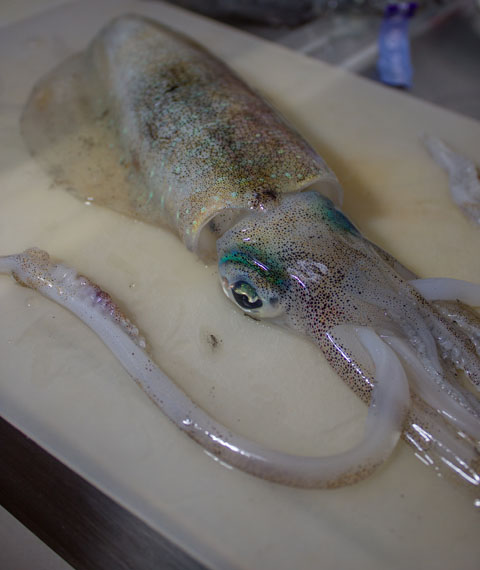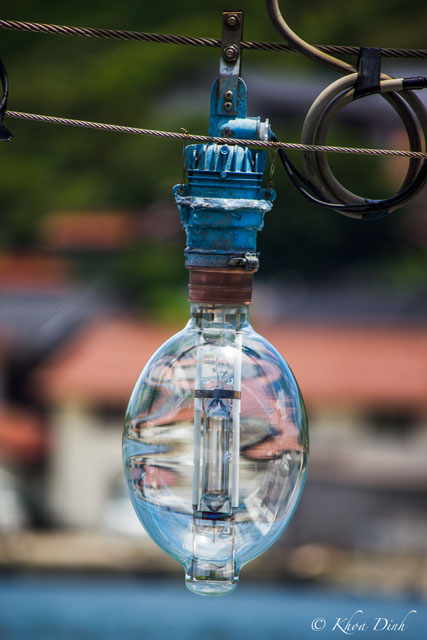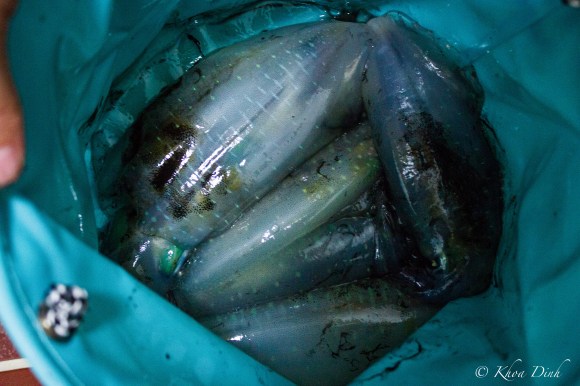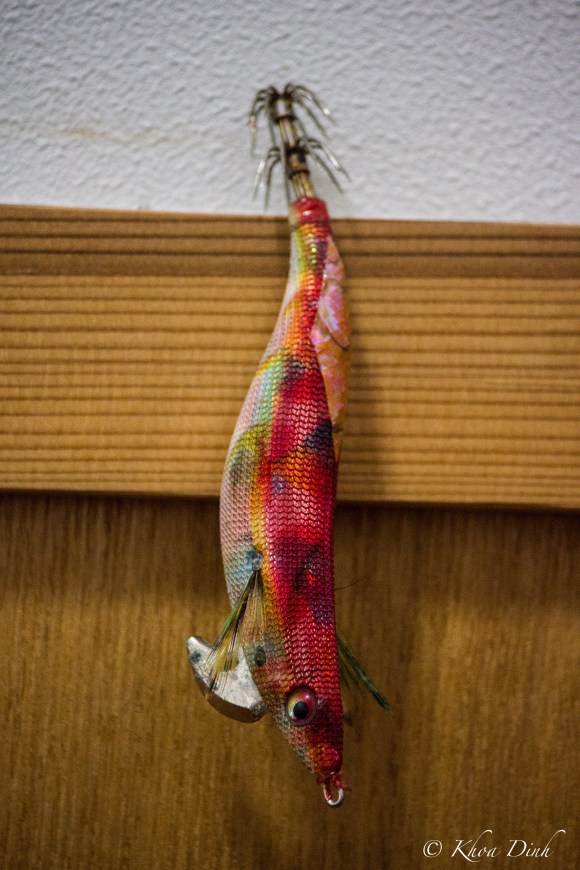 You, Me, And a Tanuki is a weekly featured blog run by Michelle, a Californian who is currently one of only two foreigners living in Chibu, a tiny fishing village on one of the Oki islands in Japan. Check back every Saturday for a new post or read more on her website here!
You, Me, And a Tanuki is a weekly featured blog run by Michelle, a Californian who is currently one of only two foreigners living in Chibu, a tiny fishing village on one of the Oki islands in Japan. Check back every Saturday for a new post or read more on her website here!
It’s squid fishing time in Chibu and when the waves aren’t too high, the horizon is sure to be speckled with the distant light of squid fishing vessels. Sometimes there are so many boats out at sea that it looks as if dawn is breaking.
Squid fishing is mostly done at night and each squid boat is equipped with large light bulbs that are used to attract squid to the boat.
^Close-up of the large light bulbs used on squid fishing vessels. The bright light attracts the squid.
In Chibu, you can also catch squid right off the side of the docks without using any lighting source. The haul isn’t as large compared to fishing out at sea, but many hobbyist fishermen in the area have brought in up to thirty squid in one outing.
One of my fishermen friends told me that squid always come in pairs. I guess they are romantic animals. It’s said that if you are able to catch the female first, the male will search for its mate around the vicinity of the boat, making for an easy catch. But if you catch the male first, the female will simply swim away and never look back. They say it’s best to catch the female first because you’re likely to get a second squid. I’m not sure if this is just an old wives’ tale (old fishermen’s tale?), but it’s an interesting story either way.
^A big bag o’ squid.
I’ve tried my hand at squid fishing off the docks near my house a few times. It was really hard for me to tell when I had a squid on the line. The lure is so light, there’s almost no drag when whipping it through the water and the squid only adds a little more resistance. I learned that if I felt even a little resistance (not even a tug) on the line, it meant I had a squid.
Every time I’ve caught a squid, it spat ink at me in an attempt to get away, so you know you’re in a good fishing spot when the cement is stained black. Once on land, the little cephalopods continue to try and swim away, making little squeaking noises in its attempts to swim through the air.
For those of you who have never seen a squid lure, here’s what it looks like:
The lure is meant to look like a shrimp. It’s weighted in the front so when you quickly whip your rod in a vertical motion, the lure scuttles through the water like a shrimp. When the squid strikes at the lure with its tentacles, it gets caught in the prickly barbs. That’s why you need to shake off the squid when unhooking it.
Many people in our area eat squid sashimi (raw squid cut up into strips and dipped in soy sauce and wasabi). Others make sushi or kalamari. I like the taste of raw squid, but it’s really chewy and took some getting used to.
How about you? Do you fish for and eat squid in your home country? Do you even like the taste of squid? Give us your thoughts in the comment section below.
Michelle is originally from California, but currently living in the tiny fishing village of Chibu, one of the Oki islands in Japan. Being one of two foreigners living in an island village of a little over 600 people presents many adventures. Come back every Saturday for a new article featuring the interesting and bizarre things she comes across in her life in rural Japan. Once a week not enough? Check out her blog, You, Me, And A Tanuki, for photographs and even more articles.
We’re still looking for more unique and interesting stories from Asia to share with the world, so drop us a line if you’d like to have your own blog featured on RocketNews24.




 Which Japanese conveyor belt sushi chain has the best squid sushi?【Taste test】
Which Japanese conveyor belt sushi chain has the best squid sushi?【Taste test】 A friendly reminder not to accidentally get squid sperm in your mouth, it hurts
A friendly reminder not to accidentally get squid sperm in your mouth, it hurts Video of teen killing squid on Twitter sparks controversy over what we know about our food
Video of teen killing squid on Twitter sparks controversy over what we know about our food Don’t drink alone! Nine Japanese snacks to accompany sake that you’ve probably never tried
Don’t drink alone! Nine Japanese snacks to accompany sake that you’ve probably never tried What it’s like to eat dancing squid in Japan for the first time
What it’s like to eat dancing squid in Japan for the first time Red light district sushi restaurant in Tokyo shows us just how wrong we were about it
Red light district sushi restaurant in Tokyo shows us just how wrong we were about it McDonald’s new Happy Meals offer up cute and practical Sanrio lifestyle goods
McDonald’s new Happy Meals offer up cute and practical Sanrio lifestyle goods Japanese ramen restaurants under pressure from new yen banknotes
Japanese ramen restaurants under pressure from new yen banknotes Sandwiches fit for a sumo served up in Osaka【Taste Test】
Sandwiches fit for a sumo served up in Osaka【Taste Test】 Tokyo Tsukiji fish market site to be redeveloped with 50,000-seat stadium, hotel, shopping center
Tokyo Tsukiji fish market site to be redeveloped with 50,000-seat stadium, hotel, shopping center Beautiful Red and Blue Star luxury trains set to be Japan’s new Hokkaido travel stars
Beautiful Red and Blue Star luxury trains set to be Japan’s new Hokkaido travel stars Anime girl English teacher Ellen-sensei becomes VTuber/VVTUber and NFT
Anime girl English teacher Ellen-sensei becomes VTuber/VVTUber and NFT Starbucks Japan adds a Motto Frappuccino to the menu for a limited time
Starbucks Japan adds a Motto Frappuccino to the menu for a limited time Historical figures get manga makeovers from artists of Spy x Family, My Hero Academia and more
Historical figures get manga makeovers from artists of Spy x Family, My Hero Academia and more Sakura tree falls on man at Sannenzaka near Kiyomizu temple in Kyoto 【Breaking News】
Sakura tree falls on man at Sannenzaka near Kiyomizu temple in Kyoto 【Breaking News】 All-you-can-drink Starbucks and amazing views part of Tokyo’s new 170 meter-high sky lounge
All-you-can-drink Starbucks and amazing views part of Tokyo’s new 170 meter-high sky lounge More foreign tourists than ever before in history visited Japan last month
More foreign tourists than ever before in history visited Japan last month French Fries Bread in Tokyo’s Shibuya becomes a hit on social media
French Fries Bread in Tokyo’s Shibuya becomes a hit on social media Studio Ghibli releases new action figures featuring Nausicaä of the Valley of the Wind characters
Studio Ghibli releases new action figures featuring Nausicaä of the Valley of the Wind characters New private rooms on Tokaido Shinkansen change the way we travel from Tokyo to Kyoto
New private rooms on Tokaido Shinkansen change the way we travel from Tokyo to Kyoto Starbucks reopens at Shibuya Scramble Crossing with new look and design concept
Starbucks reopens at Shibuya Scramble Crossing with new look and design concept Studio Ghibli glasses cases let anime characters keep an eye on your spectacles
Studio Ghibli glasses cases let anime characters keep an eye on your spectacles Beautiful Ghibli sealing wax kits let you create accessories and elegant letter decorations【Pics】
Beautiful Ghibli sealing wax kits let you create accessories and elegant letter decorations【Pics】 Studio Ghibli releases Kiki’s Delivery Service chocolate cake pouches in Japan
Studio Ghibli releases Kiki’s Delivery Service chocolate cake pouches in Japan New definition of “Japanese whiskey” goes into effect to prevent fakes from fooling overseas buyers
New definition of “Japanese whiskey” goes into effect to prevent fakes from fooling overseas buyers Our Japanese reporter visits Costco in the U.S., finds super American and very Japanese things
Our Japanese reporter visits Costco in the U.S., finds super American and very Japanese things Studio Ghibli unveils Mother’s Day gift set that captures the love in My Neighbour Totoro
Studio Ghibli unveils Mother’s Day gift set that captures the love in My Neighbour Totoro New Japanese KitKat flavour stars Sanrio characters, including Hello Kitty
New Japanese KitKat flavour stars Sanrio characters, including Hello Kitty New Pokémon cakes let you eat your way through Pikachu and all the Eevee evolutions
New Pokémon cakes let you eat your way through Pikachu and all the Eevee evolutions Disney princesses get official manga makeovers for Manga Princess Cafe opening in Tokyo
Disney princesses get official manga makeovers for Manga Princess Cafe opening in Tokyo Sales of Japan’s most convenient train ticket/shopping payment cards suspended indefinitely
Sales of Japan’s most convenient train ticket/shopping payment cards suspended indefinitely Sold-out Studio Ghibli desktop humidifiers are back so Totoro can help you through the dry season
Sold-out Studio Ghibli desktop humidifiers are back so Totoro can help you through the dry season Japanese government to make first change to romanization spelling rules since the 1950s
Japanese government to make first change to romanization spelling rules since the 1950s Ghibli founders Toshio Suzuki and Hayao Miyazaki contribute to Japanese whisky Totoro label design
Ghibli founders Toshio Suzuki and Hayao Miyazaki contribute to Japanese whisky Totoro label design Doraemon found buried at sea as scene from 1993 anime becomes real life【Photos】
Doraemon found buried at sea as scene from 1993 anime becomes real life【Photos】 Tokyo’s most famous Starbucks is closed
Tokyo’s most famous Starbucks is closed One Piece characters’ nationalities revealed, but fans have mixed opinions
One Piece characters’ nationalities revealed, but fans have mixed opinions We asked a Uniqlo employee what four things we should buy and their suggestions didn’t disappoint
We asked a Uniqlo employee what four things we should buy and their suggestions didn’t disappoint Princesses, fruits, and blacksmiths: Study reveals the 30 most unusual family names in Japan
Princesses, fruits, and blacksmiths: Study reveals the 30 most unusual family names in Japan Dom Dom’s Squid Devil Burger is here to shake up the gourmet scene like a tokusatsu bad guy
Dom Dom’s Squid Devil Burger is here to shake up the gourmet scene like a tokusatsu bad guy Cup Noodle instant ramen adds disturbingly named new topping: “almost squid!”
Cup Noodle instant ramen adds disturbingly named new topping: “almost squid!” Pitch-black instant ramen added to Cup Noodle lineup to fill dark hole in our ramen-loving hearts
Pitch-black instant ramen added to Cup Noodle lineup to fill dark hole in our ramen-loving hearts We try the new, limited edition squid viscera potato chips from Japan【Taste Test】
We try the new, limited edition squid viscera potato chips from Japan【Taste Test】 Splatoon’s squid vs octopus Splatfest asks deep questions, ruins marriages
Splatoon’s squid vs octopus Splatfest asks deep questions, ruins marriages We prepared our own delicious amberjack sashimi and realized how much money it saved us【Pics】
We prepared our own delicious amberjack sashimi and realized how much money it saved us【Pics】 Revolving sushi restaurant’s “Sushi of the World” Festival brings unusual fish to the table
Revolving sushi restaurant’s “Sushi of the World” Festival brings unusual fish to the table Japan’s top 10 hotel breakfasts 2016: Kobe hotel tops the list once again!
Japan’s top 10 hotel breakfasts 2016: Kobe hotel tops the list once again! Japan’s 10 weirdest ice cream flavors
Japan’s 10 weirdest ice cream flavors Terrifying Cthulhu-yaki created by lazy Japanese home chef
Terrifying Cthulhu-yaki created by lazy Japanese home chef Stingray devours tank-mate squid at Japanese aquarium, shows what nature is really like 【Video】
Stingray devours tank-mate squid at Japanese aquarium, shows what nature is really like 【Video】 Who’s got the best, cheapest one-person sushi delivery in downtown Tokyo? Mr. Sato investigates!
Who’s got the best, cheapest one-person sushi delivery in downtown Tokyo? Mr. Sato investigates! Drink, cook, eat — New “Ika Glass” is a cup made entirely of squid【Pics】
Drink, cook, eat — New “Ika Glass” is a cup made entirely of squid【Pics】 We encountered the most frightening fried chicken in Ameyokocho in Tokyo, and ate it anyway
We encountered the most frightening fried chicken in Ameyokocho in Tokyo, and ate it anyway Pizza evolution! We try mochi-dough “stick pizza” from Roppongi’s EU Shokudou
Pizza evolution! We try mochi-dough “stick pizza” from Roppongi’s EU Shokudou
Leave a Reply